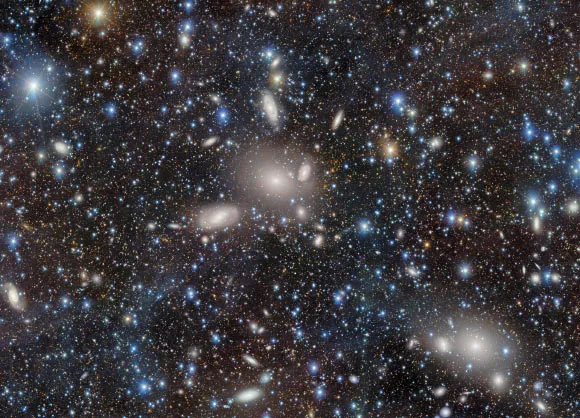
DECam Reveals Stunning Details of Antlia Galaxy Cluster: A Cosmic Mystery Unfolds!
2025-01-01
Author: Nur
Introduction
The Antlia galaxy cluster, an astounding assembly of at least 230 galaxies, is drawing the attention of astronomers as it showcases unique attributes that distinguish it from other clusters. Unlike most galaxy clusters, Antlia lacks a central dominant galaxy, making it a fascinating subject of study for researchers seeking to understand the evolution of such massive organizations of stars.
Galaxy Clusters Overview
Galaxy clusters, crucial building blocks of the Universe, generally comprise thousands of galaxies of varying ages, shapes, and characteristics. They typically possess a mass around one million billion times greater than that of our Sun and evolve over billions of years as smaller galaxy groups coalesce under the force of gravity.
Historical Context
These galactic behemoths were once considered the largest structures in the cosmos until superclusters, vast assemblies of multiple galaxy clusters spanning hundreds of millions of light-years, were discovered in the 1980s. Despite this, the gravitational cohesion of galaxy clusters ensures they maintain their status as the most massive gravitationally-bound structures in the Universe.
Astrophysics Insight
Astrophysicists from the National Optical-Infrared Astronomy Research Laboratory (NOIRLab) highlight, “Galaxy clusters are some of the largest known structures in the Universe. Current models indicate that massive structures like these originate from clumps of dark matter, pulling together to form groups of dozens of galaxies, which subsequently merge into larger clusters.”
Location of the Antlia Cluster
Located approximately 130 million light-years from Earth in the constellation of Antlia, the Antlia cluster—also referred to as Abell S636—is the third nearest cluster to our Local Group, following the Virgo and Fornax clusters. The Dark Energy Camera (DECam), mounted on the National Science Foundation's Víctor M. Blanco 4-meter telescope at Cerro Tololo Inter-American Observatory in Chile, captured breathtaking new images of Antlia, showcasing not only its 230 known galaxies but also thousands of more distant background galaxies.
Merging Galaxies
Within the Antlia cluster, researchers have identified two colossal elliptical galaxies: NGC 3268 and NGC 3258. Evidence from X-ray observations suggests that these central galaxies are in the process of merging, which is supported by the discovery of a 'rope' of globular clusters illuminating the region of light connecting them. This observation may indicate that the Antlia cluster is, in fact, two smaller clusters blending together.
Diversity of Galaxies
Notably, the Antlia cluster is rich in lenticular galaxies—disk-shaped galaxies with minimal interstellar matter, resulting in low star formation rates—and features some irregular galaxies as well. A variety of rare, low-luminosity dwarf galaxies, including ultra-compact dwarfs and blue compact dwarfs, have been cataloged in this cluster, hinting at a significant diversity in galaxy formation and characteristics.
Speculations on Additional Galaxy Types
Astronomers suspect the cluster may also harbor dwarf spheroidal galaxies and ultra-diffuse galaxy types, but further studies and observations are necessary to confirm their existence. The exploration of these varied galaxy types is pivotal for plotting the intricate details of galaxy evolution and understanding dark matter, which constitutes about 25% of our Universe.
Conclusion and Future Exploration
As exploration continues, the Antlia galaxy cluster remains a treasure trove of cosmic knowledge, promising to unveil the mysteries of galaxy formation and the enigmatic nature of dark matter. Stay tuned for more breathtaking discoveries as scientists dive deeper into the cosmic wonders of the Antlia cluster!
 Brasil (PT)
Brasil (PT)
 Canada (EN)
Canada (EN)
 Chile (ES)
Chile (ES)
 Česko (CS)
Česko (CS)
 대한민국 (KO)
대한민국 (KO)
 España (ES)
España (ES)
 France (FR)
France (FR)
 Hong Kong (EN)
Hong Kong (EN)
 Italia (IT)
Italia (IT)
 日本 (JA)
日本 (JA)
 Magyarország (HU)
Magyarország (HU)
 Norge (NO)
Norge (NO)
 Polska (PL)
Polska (PL)
 Schweiz (DE)
Schweiz (DE)
 Singapore (EN)
Singapore (EN)
 Sverige (SV)
Sverige (SV)
 Suomi (FI)
Suomi (FI)
 Türkiye (TR)
Türkiye (TR)
 الإمارات العربية المتحدة (AR)
الإمارات العربية المتحدة (AR)